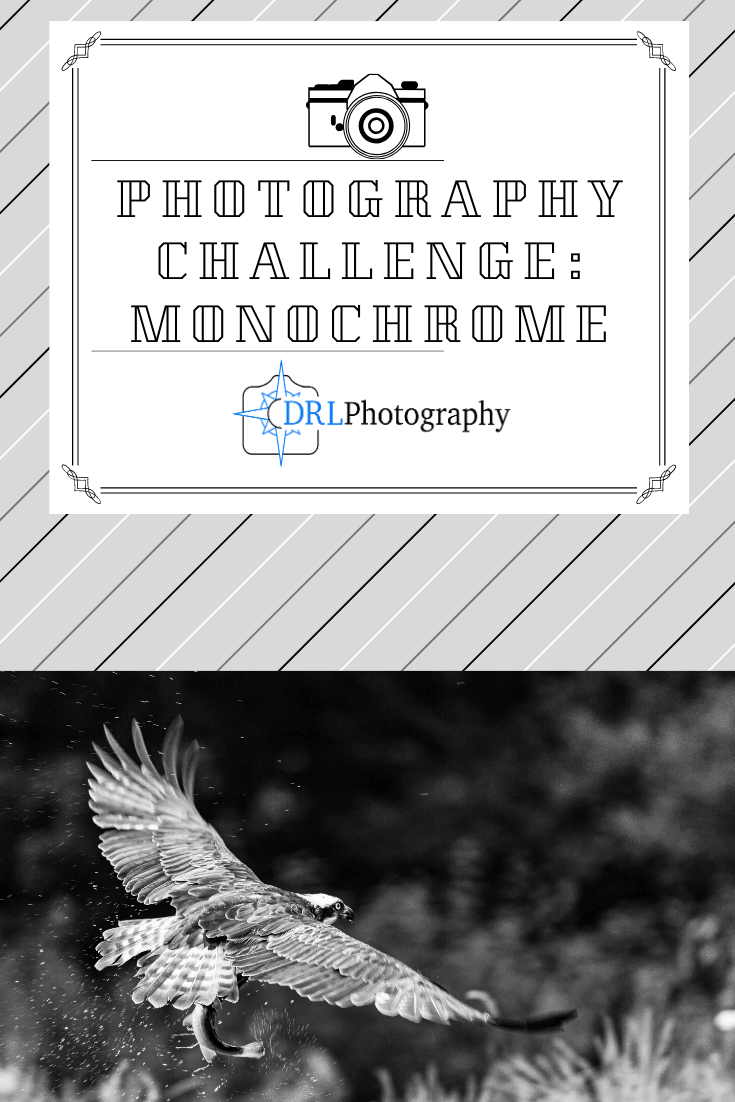Photography Challenge: Monochrome
My first experience with photography that actually grew my passion and made me want to pursue this as first a hobby and eventually as a career was when I was in school and I was using a film camera to take monochrome images.
I had to take the picture, develop the film, and print the pictures all myself. It was a very tactile introduction to the field of photography that I find myself missing now that everything is on the computer.
I continue to strive for this ideal of moving away from the computer and making photography tactile again, which is why at some point soon I will be investing in my own printer, so that I can create and control the printing and feel a connection with everything that I produce.
Besides the tactile nature of film, I am still drawn to taking monochrome images. If you look through my galleries you will no doubt notice that indeed I still convert some of my images to black and white.
This is because I simply love the textural/tonal nature of monochrome. If you have never converted an image to monochrome then I hope this challenge will inspire you to give it a go!
This is a challenge so after reading through my examples and ideas, I want you to have a go and get some great images and have fun! The best examples I will include in a future article, with links to the creator’s social media/website. Show me what you can do by sending your photos to me at:
E-mail: info@drlphotography.co.uk
Disclaimer
All images shared with me will remain the property of the creator and will only be displayed with their permission. If you wish to use your own watermark to protect your images and show your brand, then please do. Anyone that has a go at the challenge and communicates with me, shall get a personal response and I hope we can discuss photography more. Your images will never be sold by me or anyone associated with this site. They are your images.
These photography challenges are about creating a community and inspiring creativity for you (my readers) and for myself. It is meant as a way of inspiring each other, critiquing each other and discussing new techniques and ideas.
Why Monochrome?
Monochrome is a fantastic way to see the world. Removing the distraction of colour and allowing the viewer to focus on the play of light on the subject.
There are 3 words that I use to describe most monochrome pictures: contrast, tone and texture.
So if a scene or subject has one of those things then converting to black and white will most often accentuate those features or even create them when they are not present.
Don’t forget that this is the way that people worked for a long time and so, creating your own images in black and white can enable you to feel connected to some of the greatest photographers of all time, like Ansel Adams. Moreover, it can lend a nostalgic sense to your images.
Let’s examine a couple of my own pictures and why I decided to convert them to monochrome.
Example 1- Old Snowy Pine
This first example I took last year in February when the UK was in the grip of the Beast from the East, an unusually cold winter that brought a lot of snow across the country.
I woke up one morning and opened the curtains to a scene straight of a fairytale, I decided to go and explore a nearby woodland (you can see the other images from this exploration here).
While walking I came across this majestic pine tree laden with snow and new I wanted a photo. When I got home I realised that to accentuate the contrast between the shadowy, gnarled pine and the pristine white of the snow I should convert the image to monochrome.
In colour the bright blue of the sky and the green and oranges of the foliage and bark just distracted from the emphasis of the snow. I felt that monochrome would give this image its best incarnation, so I converted it and I changed the levels to create this image.
Example 2 - Melting Stone
I captured this when out for a walk near St Monan’s in Fife, Scotland earlier this year.
Earlier in the day I had gone out to try and photograph the infamous breakwater in the village at sunrise, but after returning to the hotel to have some breakfast I wanted to show my girlfriend this beautiful little fishing village on Scotland’s East coast.
We walked along the coast and on the path is this wall of stone, and I knew immediately I wanted a monochrome picture. Looking at the undulations and texture that erosion has created was a simplistic, abstract and fascinating subject.
The best option for this type of subject, in my opinion, is most definitely monochrome. It removes the distraction of colour, in this case the wall was an off yellow, grey colour which was very off putting.
But when in monochrome the textures of this subject and the increased contrast really create a dramatic image.
Example 3 - Monochrome Glide
Monochrome doesn’t have to be exclusive to landscape and abstract images either, after all this example is an osprey.
Some people may regard wildlife photography as a subject which should only ever be represented in colour, but as I mentioned above for a long time black and white was the only way you could capture images.
I chose to convert some of my osprey images because I had quite a few of them, for one thing, and because the textures of the feathers are more easily visible in monochrome than in colour.
Ospreys are a creamy white and brown bird, and they look fabulous in colour, but in black and white the accents around the shapes of the feathers and the way the feathers can reflect light becomes more visible and visually intriguing.
Conclusion
Really I have only 3 reasons to convert to monochrome:
Accentuate the texture, tone or contrast of the image
Remove the distraction of colour
Nostalgia!
Often when I am exploring and seeing a scene for the first time, I will ask myself if that scene would look better in monochrome or if I want the colour for a specific reason.
Sometimes, the fact that I ask myself those questions has enabled me to capture a picture that I would have overlooked if I had only been thinking about the colour finish, because for one reason or another I felt that there was something wrong with the colour version.
Being able to think in black and white can be a fun diversion and can enable you to find more images than you thought.
But that being said, it’s not to everyone’s taste, my girlfriend hates monochrome with a passion and always asks me why I converted an image.
But for me sometimes monochrome trumps colour. Have a go yourself and let me know what you think!
This is a challenge so after reading through my examples and ideas, I want you to have a go and get some great images and have fun! The best examples I will include in a future article, with links to the creator’s social media/website. Show me what you can do by sending your photos to me at:
E-mail: info@drlphotography.co.uk
Disclaimer
All images shared with me will remain the property of the creator and will only be displayed with their permission. If you wish to use your own watermark to protect your images and show your brand, then please do. Anyone that has a go at the challenge and communicates with me, shall get a personal response and I hope we can discuss photography more. Your images will never be sold by me or anyone associated with this site. They are your images.
These photography challenges are about creating a community and inspiring creativity for you (my readers) and for myself. It is meant as a way of inspiring each other, critiquing each other and discussing new techniques and ideas.
Related Articles
Written by Daniel Long
Daniel Long created DRL Photography as a place to showcase his work as a photographer. Daniel has learnt a lot about photography and wishes to impart this knowledge with you, although the world is an ever changing place and he always says “you can never learn everything.” So as he makes his way, he continues to learn knew techniques, skills and information about photography. He focuses on Landscape and Wildlife photography and Daniel has a special focus on Scotland, his home away from home. As well as writing about photography and taking pictures out in the field, Daniel offers guided photography days so he can share his knowledge and locations in an effort to give his clients the best opportunities possible. Have a browse around this website to see his images, guided experiences and articles about photography. If you have any questions don’t hesitate to get in contact.















